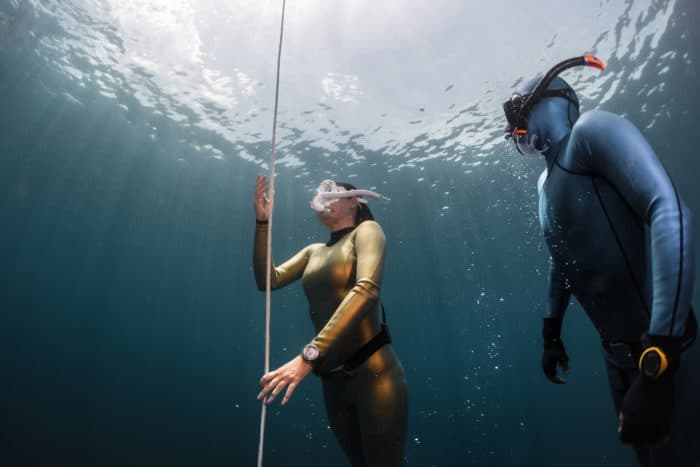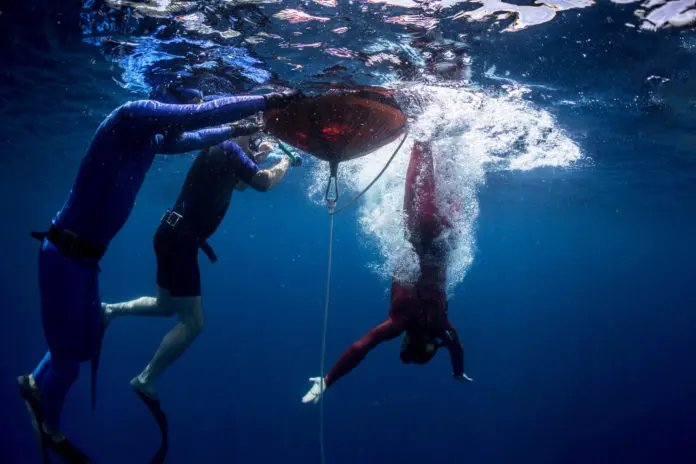Continuing from our article on common mistakes beginner freedivers make, we will discuss 5 more common mistakes that intermediate freedivers make. With mastery of relaxation, technique, and equalization, depth eventually follows. But this is where freedivers might start to get too confident, or feel too pressured to perform. Instead of gradually increasing the depth and focusing more on technique rather than the numbers, they may become nervous or overwhelmed, and face an entirely new set of problems than the ones they had as beginners. Here, we will refer to an intermediate freediver as one that is diving from 20 to 40m (65 to 131ft). Take a look at 5 common mistakes that intermediate freedivers face while training.
Freefall technique
Freefall, while being arguably the most fun and relaxing part of freediving, is not so simple to master. Often, freedivers who need to work on their freefall technique end up falling in a slanted position; their heads are close to the line, therefore they think their entire bodies are close to the line when in reality, their legs are far behind them. This seriously slows down the freefall, which needlessly increases their total dive time. Experiment with streamlined and relaxed posture and work with an experienced coach or instructor on your freefall, or have a buddy film your freefall and verify that your posture is correct and that your dive time is appropriate.
Relaxing the core for equalization
There are many freedivers that think that their Frenzel abilities stop at depths shallower than their true failure depth. They are unable to equalize past such depths, are feeling pressure on their chests, and believe that it is time to learn Mouthfill. Instead, this is when you need to focus on getting to know your two new best friends: relaxation and Uddiyana Bandha. Relaxing your core will allow your diaphragm to freely move upward, which helps your lungs compress with pressure without being restricted. This is where you also want to start practicing Uddiyana Bandha, which will increase your diaphragm flexibility and allow you to have a smaller residual lung volume; this will allow you to take your Frenzel deeper.
Learning Mouthfill too quickly
Mouthfill is an incredibly useful equalization method. While being rather complicated to learn, it can really open you up to new depths – sometimes before you are even ready for them. Mouthfill can also be seen as a shortcut; instead of working on chest and diaphragm flexibility and focusing more than ever on relaxation to be able to Frenzel deeper, too many freedivers begin focusing on Mouthfill in order to get bigger depth numbers, faster. Unfortunately, if you are not freediving conservatively, this can open you up to injuries if you make too big of jumps between depths and your body is not properly adapted. Some argue that Mouthfill should not be learned until after 40 to 50m (131 to 164ft), after the freediver has gained more experience and can understand the risks associated with this type of equalization.
Lung-packing
Lung-packing is a controversial subject amongst freedivers, and for good reason; it can be dangerous if not done correctly. Packing is a tool that some top competitive freedivers use in order to get to the great depths they reach, therefore it should never be used for shallower depths. If you are only able to get to 40m or less by packing, then it is time to go back to the drawing board and work on equalization, relaxation, and flexibility. There should never be any reason to use lung packing at this depth range.
Going too deep, too fast
Freediving should not be about numbers. On the one hand, if a freediver specifically came somewhere to train, such as Dahab, and only has a few weeks there, they may feel pressured to reach a new personal best, even if it means rushing. On the other hand, there are freedivers whose numbers matter to them, and who are competitive without even entering any competitions. Chasing bigger numbers and deeper depths comes with risks; injury being the biggest one. Failure to adapt yourself to a depth can cause barotrauma to your lungs, throat, and ears. Another problem is that speeding through new personal bests can cause you to hit a wall eventually, and if this wall is psychological, it can take a long time to overcome. It is best to increase depth by one to two meters slowly; make sure you adapt yourself to a depth before trying to push yourself deeper and always take your time.
Final Notes

Freediving is not a race. Your journey to the ocean’s depths should not be about bigger numbers or racing against your friends to go deeper. Everyone’s limits and abilities are different, and no one is judging you on yours. Freediving is about getting to know your own body and respecting its limits, not pushing them. So the next time you go train, focus less on the numbers, and more on the feeling you have during the dive. Was it an easy dive? Were you relaxed? How was equalization? Make sure that you take the time to train outside of the water as much as inside, and remember that every dive should end with a smile.

